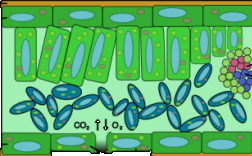
▪ Bible Physics ▪ Epinasty ▪ Plant Senescence Theory ▪ Scripture Evolution ▪ Socrates/Plato Civilization Cycle ▪ Speculations of Why Sexes Exist ▪
▪ 1986 Version ▪ 1995 Version ▪ 1999 Version ▪ 2003 Version ▪ 2007 Version a ▪ 2007 Version b ▪ Current Version ▪
 |
| An Epinastic Tomato Plant Image from Rich Arteca's Research Page |
Explaining Epinasty
Bu makale Türkçe'ye çevrilmiştir.
 |
| Weeping Willow may be in a state of permanent Epinasty. Image from Wikimedia Commons. Image is GNU Free Documentation Licensed |
Experiments have shown that the part of the flooding experience that induces the release of ethylene, is the anoxia of the roots or the lack of oxygen. Indeed, ethylene induces the growth of hollow tubes in flooded roots. These tubes become connected to "adventitious roots" which are post-flooding roots that grow out from the base of the stem above the water line. Along with the hollow tubes these roots appear to act like a snorkel providing oxygen to the roots.
It has also been verified that roots get at least some of their oxygen from between the soil particles and not transported from the leaves above. Thus it is critical for a flooded plant to empty water out from between it's roots.
In this author's opinion, the epinastic strategy during flooding may be adopted because the downward directed leaves act as sails in the wind, and the wind action on the leaf acts acts like a lever water pump. The idea is that flooded plants need to pump water out of spaces surrounding the roots as quickly as possible. Epinasty them does this by perhaps pumping more water up from the roots than would be done with ordinary transpiration. Perhaps the ethylene also induces the growth of an "anti-backflow" or one way valve of some sort to grow, for instance at the base of the leaf stem.
|
|
|
Does a one way valve get created by ethylene to increase the water in the interstitial spaces? Do the guard cells themselves act as one way valves? Image from Wikimedia Commons. Image is GNU Free Documentation Licensed |
Looking at Willow trees, it is perhaps not just in periodic flooding conditions that epinastic type growth patterns are needed. It may be a permanent feature in some plants and trees. Because they grow on river banks, Weeping Willows certainly would seem to have permanently flooded roots requiring vigorous effort by the plant to allow the roots to respire. Every time a breeze goes through a Willow, may be a hundred thousand tiny water pumps are engaged. Interestingly also it has been revealed to this author that Willow roots are blood red. This could mean they contain iron rich macro molecules like the heme molecules found in animal blood, ferrying oxygen from adventitious roots or the leaves to the water ensconced roots.
Salicylic Acid (SA) is found in particular high quantities in at least the Willow bark. It's known that this plant hormone keeps guard cells open the effect of which obviously increases transpiration. Perhaps Salicylic Acid causes epinasty too and the water pumps would be supplemental increasers of transpiration by increasing the water pressure.
Looking at wilted leaves as being similar to epinastic ones brings up yet another possibility. Abscisic Acid is released during desiccation (lack of water) closing guard cells and preventing water evaporation. Thus we should expect no movement of fluid up to the leaves when ABA is present. ABA also seems to cause leaf wilting. Perhaps part of wilting of leaves is deliberate epinastic downward growth of leaves. Perhaps too a plant needs to circulate water even when it is desiccated. Like a heart, epinasty might be a pump to move fluid around when things get dry.
|
|
|
Is Epinasty induced to produce a hand water pump effect, with the leaves acting as the pump lever and the stomata or some other cells acting like valves? Flickr image is from iBjorn's photo stream. See: http://flickr.com/photos/bjornb/. |
So maybe epinasty occurs in three circumstances, first when too much water or root flooding causes anoxia or lack of oxygen in the roots and thus the release of Ethylene. The ethylene induced epinasty helps drain the roots of water allowing respiration again. Secondly when root flooding is a permanent condition, a plant might keep high levels of Salicylic Acid (SA) around to keep guard cells open and to to cause epinasty. It might use SA instead of Ethylene because SA is a growth hormone and Ethylene is a senescence one which gets in the way of growth (see my plant hormone theory). Thirdly it might occur during desiccation and induced be by ABA, when water circulation is still needed but transpiration is not available.
A simpler explanation for Epinasty is that the sloping of the leaf is to simply allow water to flow off the leaf under heavy rain conditions. Even though the top part of the leaf is protected by a wax in most plants, standing pools of water on leaves, may not be good in most cases due to the disease fostering and rapid heat transfer properties of water.
Also a much simpler explanation of why moving the leaf up in down in the wind is advantageous, is that it increases transpiration all by itself, just like blowing on hot soup evaporates more liquid then if the soup cools itself. Also plants that get habitually flooded may have very many small thin leaves, instead of fewer bigger thicker ones (by nick weigel). This being done in order to increase surface area and transpiration rates. The Willow would again be the example.
Nevertheless the mechanical idea of the water pump should not be dismissed out of hand by claiming it's too anthropomorphic. It may help explain gaps in transpiration rates seen in current theories. Also there may be no other explanation of how ABA causes a continuing fluid circulation in the plant, if it does.

